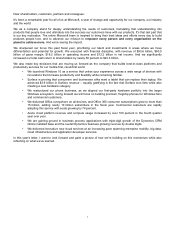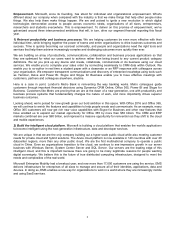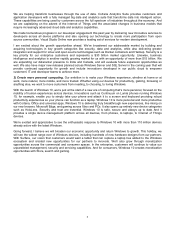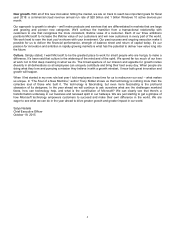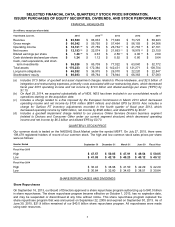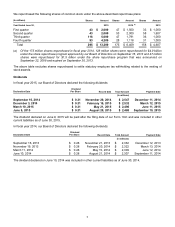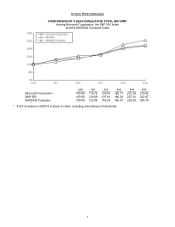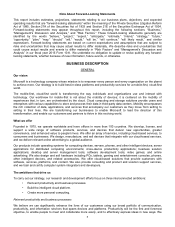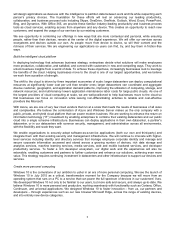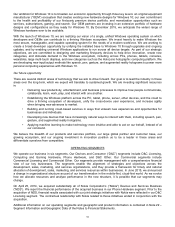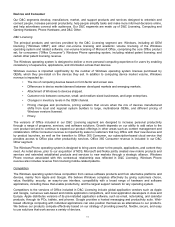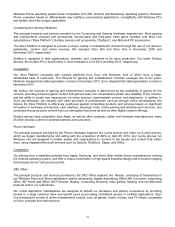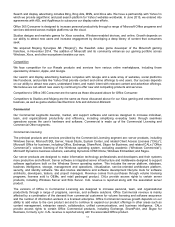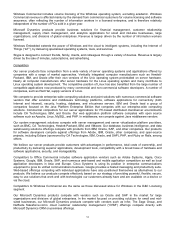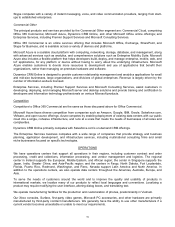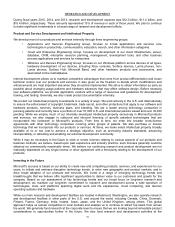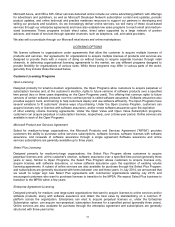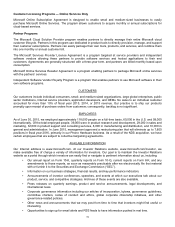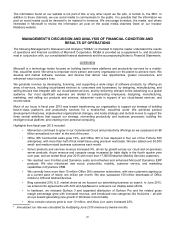Microsoft 2015 Annual Report Download - page 11
Download and view the complete annual report
Please find page 11 of the 2015 Microsoft annual report below. You can navigate through the pages in the report by either clicking on the pages listed below, or by using the keyword search tool below to find specific information within the annual report.
10
Our ambition for Windows 10 is to broaden our economic opportunity through three key levers: an original equipment
manufacturer (“OEM”) ecosystem that creates exciting new hardware designs for Windows 10; our own commitment
to the health and profitability of our first-party premium device portfolio; and monetization opportunities such as
services, subscriptions, gaming, and search. Our OEM partners are investing in an extensive portfolio of hardware
designs and configurations as they ready for Windows 10. By December 2015, we anticipate the widest range of
Windows hardware ever to be available.
With the launch of Windows 10, we are realizing our vision of a single, unified Windows operating system on which
developers and OEMs can contribute to a thriving Windows ecosystem. We invest heavily to make Windows the
most secure, manageable, and capable operating system for the needs of a modern workforce. We are working to
create a broad developer opportunity by unifying the installed base to Windows 10 through upgrades and ongoing
updates, and by enabling universal Windows applications to run across all device targets. As part of our strategic
objectives, we are committed to designing and marketing first-party devices to help drive innovation, create new
categories, and stimulate demand in the Windows ecosystem, including across PCs, phones, tablets, consoles,
wearables, large multi-touch displays, and new categories such as the HoloLens holographic computing platform. We
are developing new input/output methods like speech, pen, gesture, and augmented reality holograms to power more
personal computing experiences with Windows 10.
Our future opportunity
There are several distinct areas of technology that we aim to drive forward. Our goal is to lead the industry in these
areas over the long-term, which we expect will translate to sustained growth. We are investing significant resources
in:
• Delivering new productivity, entertainment, and business processes to improve how people communicate,
collaborate, learn, work, play, and interact with one another.
• Establishing the Windows platform across the PC, tablet, phone, server, other devices, and the cloud to
drive a thriving ecosystem of developers, unify the cross-device user experience, and increase agility
when bringing new advances to market.
• Building and running cloud-based services in ways that unleash new experiences and opportunities for
businesses and individuals.
• Developing new devices that have increasingly natural ways to interact with them, including speech, pen,
gesture, and augmented reality holograms.
• Applying machine learning to make technology more intuitive and able to act on our behalf, instead of at
our command.
We believe the breadth of our products and services portfolio, our large global partner and customer base, our
growing ecosystem, and our ongoing investment in innovation position us to be a leader in these areas and
differentiate ourselves from competitors.
OPERATING SEGMENTS
We operate our business in six segments. Our Devices and Consumer (“D&C”) segments include D&C Licensing,
Computing and Gaming Hardware, Phone Hardware, and D&C Other. Our Commercial segments include
Commercial Licensing and Commercial Other. Our segments provide management with a comprehensive financial
view of our key businesses. The segments enable the alignment of strategies and objectives across the
development, sales, marketing, and services organizations, and they provide a framework for timely and rational
allocation of development, sales, marketing, and services resources within businesses. In June 2015, we announced
a change in organizational structure as part of our transformation in the mobile-first, cloud-first world. As we evolve
how we allocate resources and analyze performance in the new structure, it is possible that our segments may
change.
On April 25, 2014, we acquired substantially all of Nokia Corporation’s (“Nokia”) Devices and Services Business
(“NDS”). We report the financial performance of the acquired business in our Phone Hardware segment. Prior to the
acquisition of NDS, financial results associated with our joint strategic initiatives with Nokia were reflected in our D&C
Licensing segment. The contractual relationship with Nokia related to those initiatives ended in conjunction with the
acquisition.
Additional information on our operating segments and geographic and product information is contained in Note 22 –
Segment Information and Geographic Data of the Notes to Financial Statements.


